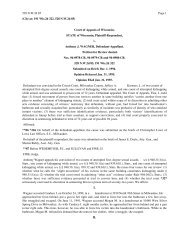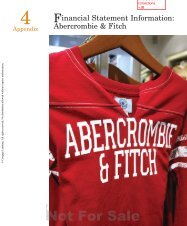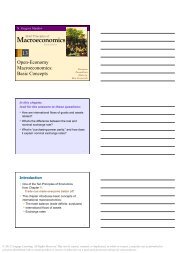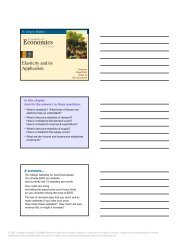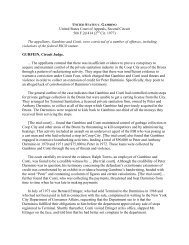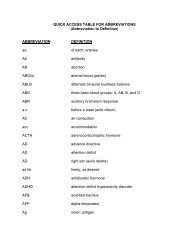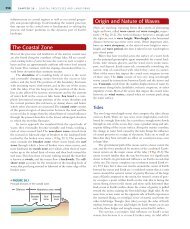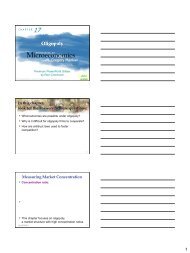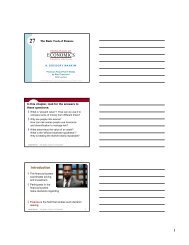8.8 Computation of Compound Probabilities
8.8 Computation of Compound Probabilities
8.8 Computation of Compound Probabilities
Create successful ePaper yourself
Turn your PDF publications into a flip-book with our unique Google optimized e-Paper software.
<strong>8.8</strong> <strong>Computation</strong> <strong>of</strong> <strong>Compound</strong> <strong>Probabilities</strong> 8-1<br />
<strong>8.8</strong> <strong>Computation</strong> <strong>of</strong> <strong>Compound</strong> <strong>Probabilities</strong><br />
P(A � B)<br />
Objectives<br />
1. Compute <strong>Probabilities</strong> <strong>of</strong> <strong>Compound</strong> Events<br />
2. Compute <strong>Probabilities</strong> <strong>of</strong> Independent Events<br />
In the previous section, we discussed how to compute the probability <strong>of</strong> a single<br />
event. For example, the probability <strong>of</strong> being dealt the very rare poker hand,<br />
1<br />
called a royal flush, is C(52,5) , about one in two and one-half<br />
million.<br />
In this section, we will discuss how to find the probability <strong>of</strong> one event or<br />
another, or the probability <strong>of</strong> one event and another. Such events are called<br />
compound events.<br />
�<br />
C(5, 5)<br />
1<br />
C(52, 5) 2,598,960<br />
�<br />
1. Compute <strong>Probabilities</strong> <strong>of</strong> <strong>Compound</strong> Events<br />
We have seen that if and are two events, the probability that and will both<br />
occur is . In this section, we also discuss , the probability that<br />
either or will occur.<br />
Suppose we want to find the probability <strong>of</strong> drawing a king or a heart from a<br />
standard card deck. If is the event “drawing a king” and is the event “drawing<br />
a heart,” then , and P(H) � . However, the probability <strong>of</strong> drawing a<br />
king or a heart is not the sum <strong>of</strong> these two probabilities. Because the king <strong>of</strong><br />
hearts was counted twice, once as a king and once as a heart, and because the<br />
1<br />
1<br />
probability <strong>of</strong> drawing the king <strong>of</strong> hearts is 52,<br />
we must subtract 52 from the sum<br />
4 13<br />
<strong>of</strong> and to get the correct probability.<br />
13<br />
P(K) � 52<br />
4<br />
A B<br />
A B<br />
P(A � B)<br />
P(A � B)<br />
A B<br />
K<br />
H<br />
52<br />
52<br />
52<br />
� 4<br />
�<br />
13<br />
16<br />
�<br />
52<br />
4<br />
P(king or heart) � P(king) � P(heart) � P(king <strong>of</strong> hearts)<br />
P(K � H) � P(K) � P(H) � P(K � H)<br />
13 1<br />
� �<br />
52 52 52<br />
In general, we have the following rule.<br />
If A and B are two events, then<br />
P(A � B) � P(A) � P(B) � P(A � B)<br />
If events A and B have no outcomes in common, then A � B �� and<br />
P(A � B) � P(�) � 0.<br />
Such events are called mutually exclusive (if one event<br />
occurs, the other cannot).<br />
Here some examples <strong>of</strong> events that are mutually exclusive and some that are<br />
not.
8-2 Chapter 8 Natural-Number Functions and Probability<br />
P(A � B)<br />
Comment<br />
A<br />
is also known as the complement<br />
<strong>of</strong> event A.<br />
P(A)<br />
Mutually exclusive events Non-mutually exclusive events<br />
Giving birth to a boy or a girl Giving birth to a boy or a baby<br />
weighing more than 6 pounds<br />
Rolling a 2 or 3 on one roll <strong>of</strong> a die Rolling a 2 or an even number on one<br />
roll <strong>of</strong> a die<br />
Drawing an ace or a king on one draw Drawing an ace or a red card from a<br />
from a standard card deck standard card deck<br />
The following rule applies to mutually exclusive events.<br />
If A and B cannot occur simultaneously, then<br />
P(A � B) � P(A) � P(B)<br />
The event A (read as “not A”)<br />
contains all outcomes <strong>of</strong> the sample space that<br />
are not elements <strong>of</strong> event A.<br />
Because the events A and A are mutually exclusive,<br />
P(A � A) � P(A) � P(A)<br />
Because either event A or event A must happen, P(A � A) � 1.<br />
Thus,<br />
P(A � A) � 1<br />
P(A) � P(A) � 1<br />
P(A) � 1 � P(A)<br />
Add �P(A) to both sides.<br />
This result gives another property <strong>of</strong> compound probabilities.<br />
If A is any event, then<br />
P(A) � 1 � P(A)<br />
EXAMPLE 1 A counselor tells a student that his probability <strong>of</strong> earning a grade <strong>of</strong> D in algebra<br />
1<br />
1<br />
is 5 and his probability <strong>of</strong> earning an F is 25.<br />
Find the probability that the student<br />
earns a C or better.<br />
Solution Because “earning a D”<br />
and “earning an F”<br />
are mutually exclusive, the probability<br />
<strong>of</strong> earning a D or F is given by<br />
� 6<br />
�<br />
25<br />
1<br />
P(D � F) � P(D) � P(F)<br />
1<br />
�<br />
5 25<br />
Note that P(D and F) � 0.<br />
The probability that the student will receive a C or better is<br />
� 19<br />
� 1 �<br />
25<br />
6<br />
P(C or better) � 1 � P(D � F)<br />
25
The probability <strong>of</strong> earning a C or better is .<br />
Self Check 1 Find the probability that the student passes (earns a D or better).<br />
Independent Events<br />
Formula for P(A � B)<br />
2. Compute <strong>Probabilities</strong> <strong>of</strong> Independent Events<br />
If two events do not influence each other, they are called independent events.<br />
The events A and B are said to be independent events if and only if<br />
P(B) � P(B ƒ A) .<br />
Here are some examples <strong>of</strong> events that are independent and some that are not.<br />
Independent events Non-independent events<br />
Drawing an ace and a king on two Drawing an ace and a king on two<br />
draws from a standard card deck draws from a standard card deck<br />
with replacement without replacement<br />
A basketball player making ten free A women catching a cold and<br />
throws in a row developing a cough<br />
A student scoring two A’s on two tests The chance it will rain and the chance<br />
the sidewalks get wet<br />
In the previous section, we discussed the multiplication property for probabilities:<br />
P(A � B) � P(A) � P(B ƒ A)<br />
Substituting P(B) for P(B ƒ A) in this property gives a formula for computing<br />
probabilities <strong>of</strong> compound independent events.<br />
If A and B are independent events, then<br />
P(A � B) � P(A) � P(B)<br />
The event A <strong>of</strong> “drawing an ace from a standard deck <strong>of</strong> cards” and the event<br />
B <strong>of</strong> “tossing heads” on one toss <strong>of</strong> a coin are independent events, because neither<br />
event influences the other. Consequently,<br />
� 1<br />
�<br />
26<br />
4<br />
P(A � B) � P(A) � P(B)<br />
P(drawing an ace and tossing heads) � P(drawing an ace) � P(tossing heads)<br />
1<br />
�<br />
52 2<br />
EXAMPLE 2 The probability that a baseball player can get a hit is 3.<br />
Find the probability that<br />
she will get three hits in a row.<br />
Solution Assume that the three times at bat are independent events: One time at bat does<br />
not influence her chances <strong>of</strong> getting a hit on another turn at bat. Because<br />
, , and P(E3) � ,<br />
1<br />
P(E2) � 1<br />
P(E1) � 1<br />
3<br />
3<br />
<strong>8.8</strong> <strong>Computation</strong> <strong>of</strong> <strong>Compound</strong> <strong>Probabilities</strong> 8-3<br />
3<br />
19<br />
25<br />
1
8-4 Chapter 8 Natural-Number Functions and Probability<br />
P(E1 � E2 � E3) � 1 1 1 1<br />
� � �<br />
3 3 3 27<br />
The probability that she will get three hits in a row is .<br />
Self Check 2 The probability that another player can get a hit is 4.<br />
Find the probability that she<br />
will get four hits in a row.<br />
EXAMPLE 3 A die is rolled three times. Find the probability that the outcome is 6 on the first<br />
roll, an even number on the second roll, and an odd prime number on the third roll.<br />
Solution The probability <strong>of</strong> a 6 on any roll is . Because there are three even integers<br />
represented on a die, the probability <strong>of</strong> rolling an even number is<br />
.<br />
Since 3 and 5 are the only odd prime numbers on a die, the probability <strong>of</strong><br />
rolling an odd prime is P(odd prime) � P(O) � .<br />
Because these three events are independent, the probability <strong>of</strong> the events happening<br />
in succession is the product <strong>of</strong> the probabilities:<br />
2<br />
P(even number) � P(E) �<br />
1<br />
6 � 3<br />
3<br />
P(6) �<br />
1<br />
6 � 2<br />
1<br />
6<br />
� 1<br />
�<br />
36<br />
1<br />
P(six and even number and odd prime) � P(6 � E � O)<br />
� P(6) � P(E) � P(O)<br />
1 1<br />
� �<br />
6 2 3<br />
Self Check 3 Find the probability that the outcome is five on the first roll, an odd number on<br />
the second roll, and two on the third roll.<br />
EXAMPLE 4 The probability that a drug will cure dandruff is 8.<br />
However, if the drug is used,<br />
1<br />
the probability that it will cause side effects is 6.<br />
Find the probability that a patient<br />
who uses the drug will be cured and will suffer no side effects.<br />
Solution The probability that the drug will cure dandruff is . The probability <strong>of</strong><br />
having side effects is P(E) � . The probability that the patient will have no side<br />
effects is<br />
1<br />
P(C) �<br />
6<br />
1<br />
8<br />
P(E) � 1 � P(E) � 1 � 1 5<br />
�<br />
6 6<br />
Since these events are independent,<br />
� 5<br />
�<br />
48<br />
1<br />
P(cure and no side effects) � P(C � E)<br />
� P(C) � P(E)<br />
5<br />
�<br />
8 6<br />
1<br />
1<br />
1<br />
27
<strong>8.8</strong> <strong>Computation</strong> <strong>of</strong> <strong>Compound</strong> <strong>Probabilities</strong> 8-5<br />
Self Check 4 Find the probability that the patient will be cured and suffer side effects.<br />
24<br />
25<br />
1<br />
256<br />
1<br />
72<br />
Self Check Answers 1. 2. 3. 4. 1<br />
<strong>8.8</strong> Exercises<br />
Vocabulary and Concepts Fill in the blanks.<br />
1. A event is one event or another or one<br />
2.<br />
event followed by another.<br />
P(A � B) �<br />
3. If A and B are<br />
P(A � B) � P(A) � P(B) .<br />
, then<br />
4. The event A is read as “ .”<br />
5. P(A) �<br />
6. Two events, A and B,<br />
are called independent events<br />
when .<br />
7. If A and B are independent events, then<br />
P(A � B) � .<br />
8. If two events do not influence each other, they are<br />
called events.<br />
Practice Assume that you draw one card from a standard<br />
card deck. Find the probability <strong>of</strong> each event.<br />
9. Drawing a black card<br />
10. Drawing a jack<br />
11. Drawing a black card or an ace<br />
12. Drawing a red card or a face card<br />
Assume that you draw two cards from a standard card<br />
deck, without replacement. Find the probability <strong>of</strong> each<br />
event.<br />
13. Drawing two aces<br />
14. Drawing three aces<br />
15. Drawing a club and then another black card<br />
16. Drawing a heart and then a spade<br />
Assume that you roll two dice once. Find the<br />
probability <strong>of</strong> each result.<br />
17. Rolling a sum <strong>of</strong> 7 or 6<br />
18. Rolling a sum <strong>of</strong> 5 or an even sum<br />
19. Rolling a sum <strong>of</strong> 10 or an odd sum<br />
20. Rolling a sum <strong>of</strong> 12 or 1<br />
48<br />
Assume that you have a bucket containing 7 beige<br />
capsules, 3 blue capsules, and 6 green capsules. You<br />
make a single draw from the bucket, taking one<br />
capsule. Find the probability <strong>of</strong> each result.<br />
21. Drawing a beige or a blue capsule<br />
22. Drawing a green capsule<br />
23. Not drawing a blue capsule<br />
24. Not drawing either a beige or a blue capsule<br />
Assume that you are using the same bucket <strong>of</strong> capsules<br />
as in Exercises 21–24.<br />
25. On two draws from the bucket, find the probability<br />
<strong>of</strong> drawing a beige capsule followed by a green<br />
capsule. (Assume that the capsule is returned to<br />
the bucket after the first draw.)<br />
26. On two draws from the bucket, find the probability<br />
<strong>of</strong> drawing one blue capsule and one green<br />
capsule. (Assume that the capsule is not returned<br />
to the bucket after the first draw.)<br />
27. On three successive draws from the bucket<br />
(without replacement), find the probability <strong>of</strong><br />
failing to draw a beige capsule.<br />
28. Jeff rolls a die and draws one card from a card<br />
deck. Find the probability <strong>of</strong> his rolling a 4 and<br />
drawing a four.<br />
29. Birthday problem Three people are in an elevator<br />
together. Find the probability that all three<br />
were born on the same day <strong>of</strong> the week.<br />
30. Birthday problem Three people are on a bus<br />
together. Find the probability that at least one<br />
was born on a different day <strong>of</strong> the week from the<br />
others.<br />
31. Birthday problem Five people are in a room<br />
together. Find the probability that all five were<br />
born on a different day <strong>of</strong> the year.<br />
32. Birthday problem Five people are on a bus<br />
together. Find the probability that at least two <strong>of</strong><br />
them were born on the same day <strong>of</strong> the year.
8-6 Chapter 8 Natural-Number Functions and Probability<br />
33. Sharing homework If the probability that Rick<br />
1<br />
will solve a problem is 4 and the probability that<br />
2<br />
Dinah will solve it is 5,<br />
find the probability that at<br />
least one <strong>of</strong> them will solve it.<br />
34. Signaling A bugle is used for communication at<br />
camp. The call for dinner is based on four pitches<br />
and is five notes long. If a child can play these<br />
four pitches on a bugle, find the probability that<br />
the first five notes that the child plays will call the<br />
camp to dinner. (Assume that the child is equally<br />
likely to play any <strong>of</strong> the four pitches each time a<br />
note is blown.)<br />
A woman visits her cabin in Canada. The probability<br />
1<br />
that her lawnmower will start is 2,<br />
the probability that<br />
1<br />
her gas-powered saw will start is 3,<br />
and the probability<br />
3<br />
that her outboard motor will start is 4.<br />
Find each<br />
probability.<br />
35. That all three will start<br />
36. That none will start<br />
37. That exactly one will start<br />
38. That exactly two will start<br />
Applications<br />
39. Immigration Three children leave Thailand to<br />
start a new life in either the United States or<br />
France. The probability that May Xao will go to<br />
1<br />
1<br />
France is 3,<br />
that Tou Lia will go to France is 2,<br />
1<br />
and that May Moua will go to France is 6.<br />
Find<br />
the probability that exactly two <strong>of</strong> them will end<br />
up in the United States.<br />
40. Preparing for the GED The administrators <strong>of</strong> a<br />
program to prepare people for the high school<br />
equivalency exam have found that 80% <strong>of</strong> the students<br />
require tutoring in math, 60% need help in<br />
English, and 45% need work in both math and<br />
English. Find the probability that a student<br />
selected at random needs help with either math or<br />
English.<br />
41. Insurance losses The insurance underwriters<br />
have determined that in any one year, the probability<br />
that George will have a car accident is 0.05,<br />
and that if he has an accident, the probability<br />
that he will be hospitalized is 0.40. Find the probability<br />
that George will have an accident but not<br />
be hospitalized.<br />
42. Grading homework One instructor grades homework<br />
by randomly choosing 3 out <strong>of</strong> the 15 problems<br />
assigned. Bill did only 8 problems. What is<br />
the probability that he won’t get caught?<br />
Discovery and Writing<br />
43. Explain the difference between dependent and<br />
independent events, and give examples <strong>of</strong> each.<br />
44. Explain why a. P(A ƒ A) � 1<br />
and<br />
b. P(A ƒ A) � 0.<br />
Review Maximize P subject to the given constraints.<br />
45. P � 2x � y<br />
46. P � 3x � y<br />
x � 0<br />
y � 0<br />
μ<br />
x � 4<br />
x � 2y � 8<br />
μ<br />
x � 0<br />
y � 0<br />
y � 2<br />
x � 2<br />
x � y � 3
8.9 Odds and Mathematical Expectation<br />
Odds<br />
Comment<br />
Note that the odds for an event is<br />
the reciprocal <strong>of</strong> the odds against<br />
the event.<br />
Objectives<br />
1. Define and Compute Odds<br />
2. Define and Compute Mathematical Expectation<br />
8.9 Odds and Mathematical Expectation 8-7<br />
At the horse races, you will <strong>of</strong>ten hear phrases such as<br />
Sweet Pea is a long shot with odds <strong>of</strong> 30 to 1.<br />
or<br />
The odds on Barbaro are 8 to 5.<br />
Since the concept <strong>of</strong> odds is closely related to the concept <strong>of</strong> probability, the<br />
pay<strong>of</strong>fs on bets at the track are based on the odds for each horse in a race.<br />
When we say that the odds on Sweet Pea are 30 to 1, we generally mean that<br />
the odds against the horse are 30 to 1. As we will soon see, this is equivalent to<br />
1 1<br />
saying that the probability <strong>of</strong> Sweet Pea winning is 30 � 1 � 31.<br />
When we say that<br />
the odds on Barbaro are 8 to 5, we mean that the probability <strong>of</strong> Barbaro winning<br />
5 5<br />
is 8 � 5 � 13.<br />
We will begin this section by discussing odds.<br />
1. Define and Compute Odds<br />
The odds for an event is the probability <strong>of</strong> a favorable outcome divided by the<br />
probability <strong>of</strong> an unfavorable outcome.<br />
The odds against an event is the probability <strong>of</strong> an unfavorable outcome divided<br />
by the probability <strong>of</strong> a favorable outcome.<br />
EXAMPLE 1 The probability that a horse will win a race is 4.<br />
Find the odds for and the odds<br />
against the horse.<br />
Solution Because the probability that the horse will win is 4,<br />
the probability that the horse<br />
3<br />
will not win is . The odds for the horse are<br />
probability <strong>of</strong> a win<br />
probability <strong>of</strong> a loss �<br />
or 1 to 3. The odds against the horse are<br />
probability <strong>of</strong> a loss<br />
probability <strong>of</strong> a win �<br />
or 3 to 1.<br />
4<br />
1<br />
4<br />
3<br />
4<br />
3<br />
4<br />
1<br />
4<br />
� 1<br />
3<br />
� 3<br />
� 3<br />
1<br />
1<br />
1
8-8 Chapter 8 Natural-Number Functions and Probability<br />
Self Check 1 The probability that a horse will lose a race is 5.<br />
Find the odds for and the odds<br />
against the horse.<br />
Another way to find the odds in favor <strong>of</strong> an event is to divide the number <strong>of</strong><br />
1<br />
favorable outcomes by the number <strong>of</strong> unfavorable outcomes. In Example 1, this is 3.<br />
To find the odds against an event, divide the number <strong>of</strong> unfavorable outcomes<br />
3<br />
by the number <strong>of</strong> favorable outcomes. In Example 1, this is .<br />
EXAMPLE 2 The odds against a horse are 30 to 1. Find: a. the probability that the horse will<br />
lose b. the probability that the horse will win<br />
Solution If p is the probability that the horse will lose, then 1 � p is the the probability that<br />
the horse will win. By definition, we have<br />
p � 30<br />
p � 30 � 30p<br />
31p � 30<br />
31<br />
30<br />
probability <strong>of</strong> losing<br />
Odds against an event �<br />
probability <strong>of</strong> winning<br />
p<br />
�<br />
1 1 � p<br />
Multiply both sides by 1 � p.<br />
Add 30p to both sides.<br />
Divide both sides by 31.<br />
The probability that the horse will lose is . The probability that the horse will<br />
win is 1 � .<br />
30<br />
31<br />
1<br />
�<br />
Self Check 2 The odds against a horse are 8 to 5. Find the probability that the horse will win.<br />
2. Define and Compute Mathematical Expectation<br />
Suppose we have a chance to play a simple game with the following rules:<br />
1. Roll a single die once.<br />
2. If a 6 appears, win $3.<br />
3. If a 5 appears, win $1.<br />
4. If any other number appears, win 50¢ .<br />
5. The cost to play (one roll <strong>of</strong> the die) is $1.<br />
In this game, the probability <strong>of</strong> any one <strong>of</strong> the six outcomes—rolling a 6, 5 4,<br />
1<br />
3, 2, or 1—is 6,<br />
and the winnings are $3, $1, and 50¢ . The expected winnings E can<br />
be found by using the following equation and simplifying the right side:<br />
E � 1<br />
6<br />
31<br />
31<br />
(3) � 1<br />
6<br />
(1) � 1<br />
6<br />
(0.50) � 1<br />
6<br />
�<br />
� 1<br />
1<br />
6 (6)<br />
� 1<br />
(3 � 1 � 0.50 � 0.50 � 0.50 � 0.50)<br />
6<br />
30<br />
1<br />
1 1<br />
(0.50) � (0.50) �<br />
6 6 (0.50)<br />
1
Mathematical<br />
Expectation<br />
Over the long run, we could expect to win $1 with every play <strong>of</strong> the game.<br />
Since it costs $1 to play the game, the expected gain or loss is 0. Because the<br />
expected winnings are equal to the admission price, the game is fair.<br />
If a certain event has n different outcomes with probabilities P1, P2, P3, . ..,<br />
Pn and the winnings assigned to each outcome are x1, x2, x3, . . . xn, the<br />
expected winnings, or mathematical expectation, E is given by<br />
E � P 1x 1 � P 2x 2 � P 3x 3 � p � P nx n<br />
EXAMPLE 3 It costs $1 to play the following game: Roll two dice; collect $5 if we roll a sum <strong>of</strong><br />
7, and collect $2 if we roll a sum <strong>of</strong> 11. All other numbers pay nothing. Is it wise<br />
to play the game?<br />
Solution The probability <strong>of</strong> rolling a 7 on a single roll <strong>of</strong> two dice is 36,<br />
the probability <strong>of</strong><br />
2<br />
28<br />
rolling an 11 is 36,<br />
and the probability <strong>of</strong> rolling something else is 36.<br />
The mathematical<br />
expectation is<br />
E � 6 2 28 17<br />
(5) � (2) � (0) � � $0.944<br />
36 36 36 18<br />
By playing the game for a long period <strong>of</strong> time, we can expect to get back<br />
about 95¢ for every dollar spent. For the fun <strong>of</strong> playing, the cost is about 5¢ a<br />
game. If the game is enjoyable, it might be worth the expected loss. However, the<br />
game is slightly unfair.<br />
Self Check 3 Is it wise to play the game if you win $4 when you roll a sum <strong>of</strong> 7 and $6 when you<br />
roll a sum <strong>of</strong> 11?<br />
5<br />
Self Check Answers 1. 4 to 1; 1 to 4 2. 13 3. Yes, the game is fair.<br />
8.9 Exercises<br />
Vocabulary and Concepts Fill in the blanks.<br />
1. The are the probability <strong>of</strong> a favorable<br />
outcome divided by the probability <strong>of</strong> an<br />
unfavorable outcome.<br />
2. The are the probability <strong>of</strong> an<br />
unfavorable outcome divided by the probability <strong>of</strong><br />
a favorable outcome.<br />
3. If the odds for an event are 1 to 4, the probability<br />
<strong>of</strong> winning is .<br />
4. Mathematical expectation E is given by<br />
E �<br />
.<br />
Practice<br />
1<br />
5. The probability that a horse will win a race is 5.<br />
Find the odds for and against the horse.<br />
8.9 Odds and Mathematical Expectation 8-9<br />
6. The probability that a horse will win a race is 3.<br />
Find the odds for and against the horse.<br />
7. The odds against a horse are 50 to 1. Find the<br />
probability that the horse will win.<br />
8. The odds against a horse are 7 to 5. Find the<br />
probability that the horse will lose.<br />
Assume a single roll <strong>of</strong> a die.<br />
9. Find the probability <strong>of</strong> rolling a 6.<br />
10. Find the odds in favor <strong>of</strong> rolling a 6.<br />
11. Find the odds against rolling a 6.<br />
12. Find the probability <strong>of</strong> rolling an even number.<br />
13. Find the odds in favor <strong>of</strong> rolling an even number.<br />
6<br />
2
8-10 Chapter 8 Natural-Number Functions and Probability<br />
14. Find the odds against rolling an even number.<br />
Assume a single roll <strong>of</strong> two dice.<br />
15. Find the probability <strong>of</strong> rolling a sum <strong>of</strong> 6.<br />
16. Find the odds in favor <strong>of</strong> rolling a sum <strong>of</strong> 6.<br />
17. Find the odds against rolling a sum <strong>of</strong> 6.<br />
18. Find the probability <strong>of</strong> rolling an even sum.<br />
19. Find the odds in favor <strong>of</strong> rolling an even sum.<br />
20. Find the odds against rolling an even sum.<br />
Assume that you are drawing one card from a standard<br />
card deck.<br />
21. Find the odds in favor <strong>of</strong> drawing a queen.<br />
22. Find the odds against drawing a black card.<br />
23. Find the odds in favor <strong>of</strong> drawing a face card.<br />
24. Find the odds against drawing a diamond.<br />
25. If the odds in favor <strong>of</strong> victory are 5 to 2, find the<br />
probability <strong>of</strong> victory.<br />
26. If the odds in favor <strong>of</strong> victory are 5 to 2, find the<br />
odds against victory.<br />
27. If the odds against winning are 90 to 1, find the<br />
odds in favor <strong>of</strong> winning.<br />
28. Find the odds in favor <strong>of</strong> rolling a 7 on a single<br />
roll <strong>of</strong> two dice.<br />
29. Find the odds against tossing four heads in a row<br />
with a fair nickel.<br />
30. Find the odds in favor <strong>of</strong> a couple having four<br />
girl babies in succession. 1Assume P(girl) � 1<br />
2 .2<br />
31. The odds against a horse are 8 to 1. Find the<br />
probability that the horse will win.<br />
32. The odds against a horse are 1 to 1. Find the<br />
probability that the horse will lose.<br />
33. It costs $2 to play the following game:<br />
a. Draw one card from a card deck.<br />
b. Collect $5 if an ace is drawn.<br />
c. Collect $4 if a king is drawn.<br />
d. Collect nothing for all other cards drawn.<br />
Is it wise to play this game? Explain.<br />
34. Lottery tickets One thousand tickets are sold<br />
for a lottery with two grand prizes <strong>of</strong> $800. Find<br />
a fair price for the tickets.<br />
35. Find the odds against a couple having three baby<br />
boys in a row. 1Assume P(boy) �<br />
36. Find the odds in favor <strong>of</strong> tossing at least three<br />
heads in five tosses <strong>of</strong> a fair coin.<br />
37. Suppose you toss a coin five times and collect $5<br />
if you toss five heads, $4 if you toss four heads,<br />
$3 if you toss three heads, and no money for any<br />
other combination. How much should you pay to<br />
play the game if the game is to be fair?<br />
38. If you roll two dice one time and collect $10 for<br />
double 6’s and $1 for double 1’s, what is a fair<br />
price for playing the game?<br />
39. Counting an ace as 1, a face card as 10, and all<br />
others at their numerical values, find the expected<br />
value if you draw one card from a card deck.<br />
1<br />
2 .2<br />
40. Find the expected sum <strong>of</strong> one roll <strong>of</strong> two dice.<br />
41. A multiple-choice test <strong>of</strong> eight questions gives<br />
five possible answers for each question. Only one<br />
<strong>of</strong> the answers for each question is right. Find the<br />
probability <strong>of</strong> getting seven right answers by<br />
simple guessing.<br />
42. In the situation described in Exercise 41, find the<br />
odds in favor <strong>of</strong> getting seven answers right.<br />
Discovery and Writing<br />
43. If “the odds are against an event,” what can be<br />
said about its probability?<br />
44. To disguise the unlikely chance <strong>of</strong> winning, a<br />
contest promoter publishes the odds in favor <strong>of</strong><br />
winning as 0.0000000372 to 1. What are the odds<br />
against winning?<br />
Review<br />
45. Find the equation <strong>of</strong> the line perpendicular to<br />
3x � 2y � 9 and passing through the point (1, 1) .<br />
46. Find the equations <strong>of</strong> the parabolas with vertex<br />
at the point (3, �2) and passing through the<br />
origin.<br />
47. Find the equation <strong>of</strong> the circle with center at<br />
(3, 5) and tangent to the x-axis.<br />
48. Write the equation<br />
2x 2 � 4y 2 � 12x � 24y � 46 � 0<br />
in standard form, and identify the curve.
CHAPTER REVIEW<br />
<strong>8.8</strong> <strong>Computation</strong> <strong>of</strong> <strong>Compound</strong> <strong>Probabilities</strong><br />
Definitions and Concepts Examples<br />
Chapter Review 8-11<br />
If A and B are two events, then<br />
Find the probability <strong>of</strong> drawing an ace or a heart on<br />
one draw from a standard card deck.<br />
P(A � B) � P(A) � P(B) � P(A � B)<br />
4 1<br />
The probability <strong>of</strong> drawing an ace is � .<br />
52 13<br />
13 1<br />
The probability <strong>of</strong> drawing a heart is � .<br />
52 4<br />
The ace <strong>of</strong> hearts has been counted both as an ace<br />
and as a heart. To get rid <strong>of</strong> the duplication, we must<br />
subtract the probability <strong>of</strong> getting the ace <strong>of</strong> hearts<br />
from the sum <strong>of</strong> the two probabilities listed above.<br />
� 4<br />
�<br />
13<br />
16<br />
�<br />
52<br />
1<br />
P(ace or a heart) � P(ace) � P(heart) � P(ace <strong>of</strong> hearts)<br />
1 1<br />
� �<br />
13 4 52<br />
If A and B cannot occur simultaneously, then<br />
Find the probability <strong>of</strong> drawing a 2 or a 3 from a<br />
standard card deck.<br />
P(A � B) � P(A) � P(B)<br />
4 1<br />
The probability <strong>of</strong> drawing a 2 is � .<br />
52 13<br />
4 1<br />
The probability <strong>of</strong> drawing a 3 is � .<br />
52 13<br />
Since there is no duplication,<br />
� 2<br />
�<br />
13<br />
1<br />
P(2 or 3) � P(2) � P(3)<br />
1<br />
�<br />
13 13<br />
If A is any event, then<br />
If the probability that a horse will win a race is , the<br />
P(A) � 1 � P(A)<br />
probability that the horse will lose the race is<br />
1 � .<br />
7<br />
11<br />
4<br />
11 � 11<br />
7
8-12 Chapter 8 Natural-Number Functions and Probability<br />
If A and B are independent events, then<br />
A basketball player makes 80% <strong>of</strong> her free throws.<br />
Find the probability that she will make 2 free throws<br />
P(A � B) � P(A) � P(B)<br />
in a row.<br />
The probability that she makes 1 free throw is<br />
80% � .<br />
4<br />
Exercises<br />
82. On one draw from a standard card deck, find the<br />
probability <strong>of</strong> drawing a two or a spade.<br />
8.9 Odds and Mathematical Expectation<br />
5<br />
So the probability that she will make 2 in a row is<br />
� 4<br />
P(1 free throw � another free throw)<br />
� P(1 free throw) � P(another free throw)<br />
4 16<br />
� �<br />
5 5 25<br />
83. If the probability that a drug cures a disease is<br />
0.83, and we give the drug to 800 people with the<br />
disease, find the expected number <strong>of</strong> people who<br />
will not be cured.<br />
Definitions and Concepts Examples<br />
The odds for an event is the probability <strong>of</strong> a favorable The probability that a politician will be elected is esti-<br />
outcome divided by the probability <strong>of</strong> an unfavorable mated to be 0.7. Find the odds for and against the<br />
outcome.<br />
politician.<br />
The odds against an event is the probability <strong>of</strong> an<br />
unfavorable outcome divided by the probability <strong>of</strong> a<br />
Odds for the politician or 7 to 3.<br />
favorable outcome.<br />
Odds against the politician � or 3 to 7.<br />
0.3<br />
�<br />
3<br />
�<br />
0.7 7<br />
0.7 7<br />
�<br />
0.3 3<br />
A game is fair if the cost to play equals the expected<br />
winnings E.<br />
Suppose it costs $5 to play the following game:<br />
Roll two dice: Collect $10 if you roll a 12 or a 2.<br />
Otherwise collect $1.<br />
Is it wise to play the game?<br />
Since the probability <strong>of</strong> rolling a 12 is 36,<br />
<strong>of</strong> rolling a<br />
1<br />
34<br />
2 is 36,<br />
and <strong>of</strong> rolling something else is 36,<br />
the<br />
mathematical expectation is<br />
E � 1 1 34<br />
(10) � (10) � (1) � 1.5<br />
36 36 36<br />
Since it costs $5 to play and the expected earnings are<br />
only $1.50, this is a foolish game to play.<br />
1
Exercises<br />
84. Find the odds against a horse if the probability<br />
7<br />
that the horse will win is 8.<br />
85. Find the odds in favor <strong>of</strong> a couple having 4 baby<br />
girls in a row.<br />
5<br />
86. If the probability that Joe will marry is 6 and the<br />
3<br />
probability that John will marry is 4,<br />
find the<br />
odds against either one becoming a husband.<br />
87. If the odds against Priscilla’s graduation from<br />
10<br />
college are 11,<br />
find the probability that she will<br />
graduate.<br />
Chapter Review 8-13<br />
88. Find the expected earnings if you collect $1 for<br />
every heads you get when you toss a fair coin<br />
4 times.<br />
89. If the total number <strong>of</strong> subsets that a set with<br />
elements can have is 2 , explain why<br />
n<br />
n<br />
anb<br />
�<br />
0<br />
a n<br />
b �<br />
1<br />
a n<br />
2 b � p �<br />
a n<br />
b � 2n<br />
n



